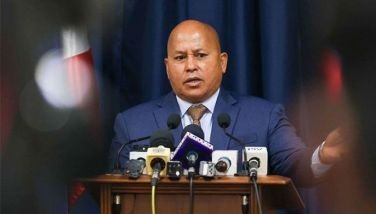Probers focus on Qantas jet oxygen tank
Australian investigators are exploring the possibility that an oxygen cylinder could have exploded midflight on the Qantas jumbo jet that made a harrowing emergency landing at the Ninoy Aquino International Airport with a giant hole in its fuselage, an official said yesterday.
The Boeing 747-400 was cruising at 29,000 feet on Friday with 346 passengers aboard when it was shaken by what passengers described as an explosion. Oxygen masks dropped from the ceiling as the plane descended rapidly and debris flew through the cabin from a hole that suddenly appeared in the floor.
En route to Melbourne, Australia, from London, the plane managed to land safely minutes later at the NAIA. There were no injuries among the passengers and crew.
Four specialists from the Australian Transport Safety Bureau inspected the aircraft Saturday and were to continue through the weekend. Boeing and the US National Transportation Safety Board were also sending specialists to assist.
The possibility of an explosion is one of several scenarios being considered by investigators, said Julian Walsh of the Australian Transport Safety Bureau.
“There are oxygen cylinders contained in the cargo compartment, but the relevance of that will certainly be covered in the investigation,” he told reporters.
An official of the US Transportation Security Administration said initial reports indicated no link to terrorism.
Meanwhile, some passengers told Australian media that their oxygen masks failed to work properly during the crisis, leading some to nearly pass out.
Other passengers, while applauding the pilot and crew’s performance, told of having to share oxygen masks between three people because of faulty or broken emergency equipment.
“Ours didn’t come down, and my husband just about (passed out) because he didn’t have any oxygen for about three minutes,” Beverley Doors told Australian Broadcasting Corp. radio.
Passenger David Saunders said one man in front of him smashed the ceiling panel in order to force his mask to come down, and that children were screaming and flailing.
“Their cheeks and lips were turning blue from lack of oxygen,” he said.
Boeing spokeswoman Liz Verdier said the design of the Qantas jet includes dozens of oxygen tanks located throughout the lower part of the aircraft, including below the passenger compartment where the hole is.
Qantas Chief Executive Officer Geoff Dixon told reporters Saturday he was “horrified” after seeing pictures of the aircraft’s gaping hole. He said it was too early to speculate on what caused the damage.
“There are thousands of aircraft flying around the world today. Things happen. Something has happened here and we cannot speculate any more about what did happen,” Dixon said.
Passengers on Flight QF 30 had just been served a meal after a stopover in Hong Kong when they heard a loud bang, then their ears popped as air rushed out of the 9-foot (3-meter) hole in the aircraft’s side.
An official of the US Transportation Security Administration said initial reports indicated no link to terrorism.
Peter Gibson, spokesman for Australia’s Safety Authority, said speculation that rust contributed to the accident could be discounted.
“It’s clearly an extremely rare and unusual event that a hole opens up in the fuselage,” he told reporters in Australia. “I know there’s a number of theories around, but they’re just that at this stage, they’re just theories. We don’t have the solid facts.”
Qantas boasts a strong safety record and has never lost a jet to an accident. The last crash of a smaller airline plane was in 1951. – AP, Rudy Santos
- Latest
- Trending

































